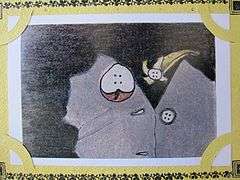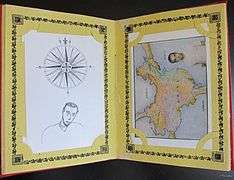Francesco Clemente
| Francesco Clemente | |
|---|---|
.jpg) | |
| Born |
March 23, 1952 Naples, Italy |
| Nationality | Italian |
| Education | Architecture, University of Rome |
| Known for | Painting, Drawing |
Francesco Clemente (born in Naples March 23, 1952) is an Italian-born contemporary artist. His work is influenced by thinkers as diverse as Gregory Bateson, William Blake, Allen Ginsberg, and J Krishnamurti. Dividing his time between New York and Varanasi, India, Clemente has adopted for his paintings a vast variety of supports and mediums, exploring, discarding, and returning to oil paint, watercolor, pastel, and printmaking. His work develops in a non-linear mode, expanding and contracting in a fragmentary way, not defined by a style, but rather by his recording of the fluctuations of the self.
Career

Clemente's work spans four decades. His work is stylistically varied, inclusive, erotic, and nomadic. It embraces diverse mediums and diverse cultures as well, aiming at finding wholeness through fragmentation and witnessing the survival of contemplation and pleasure in our mechanical age.
Clemente's work is rooted in political utopia and expresses an anti-materialistic stance. In the 1970s he moved from photography to drawing and anticipated the return to painting of the 1980s.
His work is also nomadic. In the 1980s he divided his time between India and New York. While briefly associated with Neo-Expressionism he took an interest in collaborative works both with Indian craftsmen and with painters like Basquiat and Warhol, and poets like Robert Creeley and Ginsberg in New York. In an interview with The Brooklyn Rail, Clemente commented "these poets had been looking at the East for inspiration and I was also anxious to evade the materialism of the West."[1]
In the 1990s Clemente explored intensely erotic imagery, inspired by the Tantra traditions both of India and Tibet, and turning contemporary preoccupations with identity and sexuality into an occasion to ask questions about the nature of the self. In the 2000s Clemente underwent a darker and grotesque phase, returning in recent years to luminous images of repose and transformation.
Since the 1980s until today, Clemente has also chronicled New York intellectual and social life through a great number of portraits, contributing to the revival of a genre until then somehow discredited.
Clemente's art has been presented in solo and group shows internationally. Major retrospectives have been held in the 1990s at the Philadelphia Museum of Art, at The Royal Academy in London, at the Centre Pompidou, Paris and at the Sezon Museum of Art, Tokyo. Clemente's art was also featured in 1999-2000 at the Solomon R Guggenheim Museum, New York, and at the Guggenheim Museum, Bilbao. In the 2000s retrospectives were held at the Irish Museum of Modern Art in Dublin, at the Museo MADRE, Naples and at the Schirn Kunsthalle, Frankfurt. An exhibition of self-portraits and of Clemente's own version of the Tarot Cards was held at the Uffizi Gallery, Florence in 2011.
The artist is currently represented by Bruno Bischofberger in Switzerland, BlainSouthern in London, and Mary Boone Gallery in New York.
Clemente's work is featured in the 1998 movie, Great Expectations.
Francesco Clemente is a member of the American Academy of Arts and Letters.
Timeline
1980s
Whitechapel Art Gallery, London, 1983; the Walker Art Center, Minneapolis, 1984 ; the Nationale Galerie, Berlin, 1984; the Metropolitan Museum of Art, New York, 1985 ; the Art Institute of Chicago, 1987; the Fundacion Caja, 1987; and the Dia Art Foundation, New York, 1988.
1990s
Philadelphia Museum of Art,[2] the Royal Academy of Arts, London, the Centre Georges Pompidou, Paris and the Sezon Museum, Tokyo.
2000 and after
Major retrospective 1999/2000, the Solomon R. Guggenheim Museum in New York and in Bilbao; Irish Museum of Modern Art, Dublin (2004); the Rose Art Museum, Massachusetts (2004); Museo Maxxi, Rome (2006), Museo Madre, Naples (2009), Schirn Kunsthalle, Frankfurt (2011), Uffizi Gallery, Florence (2011) and Yale University (2013).
Recent exhibitions
- The Tarot, Francesco Clemente at the Uffizi, unofficial guide and blog, September 8th - November 6th, 2011
- Palimpsest, Schirn Kunsthalle, Frankfurt June 8th - September 4th, 2011
- JK's Walk, Galeria Javier Lopez - Mario Sequeira, Madrid,October 27th - February 3rd, 2012
- Winter Women, Summer Self, Galeria Lorcan Oneill, Rome May 27th - July 30th, 2011
- Ménage à Trois - Warhol, Basquiat, Clemente, Federal Art and Exhibition Hall, Bonn, Germany, February 10th - May 20th, 2012
- Francesco Clemente: Inspired by India, Rubin Museum of Art, New York City, September 5, 2014 - February 2, 2015
Works
- A History of the Heart in Three Rainbows[3]
- Bestiary
- Map Of What Is Effortless- 1978 Gouache on paper 60 x 57 in 152.4 x 144.8 cm
- Inside Outside
- Sun
- Atlas
- Fire
- Abbraccio
- From Story of my life
- Scissors and Butterflies
- ''Undae Clemente flamina pulsae'', Francesco Clemente, 1978, Groninger Museum
-

-

-

-

See also
Further reading
Books
- Seidel, Max. Francesco Clemente: The Tarots. Hirmer Publishers. February 15, 2012. Amazon ISBN 9783777445212
- Clemente,Francesco; Hollein, Max and Walcott, Derek. Francesco Clemente: Palimpsest. Moderne Kunst Nürnberg. March 31, 2012. Barnes and Noble ISBN 9783869842257
- Danto, C. Artur. Francesco Clemente: The Sopranos. Charta. January 9, 2008. Barnes and Noble ISBN 9788881586981
- Clemente,Francesco; Walcott, Derek. Francesco Clemente: Three Rainbows. Charta. October 31, 2009. Barnes and Noble ISBN 9788881587452
- Clemente,Francesco; Danto, Arthur. Francesco Clemente: A Private Geography. Charta. February 28, 2011. Barnes and Noble ISBN 9788881587957
- Jain, Jyotindra. Clemente: Made in India. Charta. September 30, 2011. Barnes and Noble ISBN 9788881588091
- Ammann, Jean- Christophe; Clemente, Francesco. Francesco Clemente: Works 1971- 1979. Charta. August 28, 2007. Barnes and Noble ISBN 9788881586509
- Matthews, Harry. Singular Pleasures. Dalkey Archive Press. November 29, 1999. Barnes and Noble ISBN 9781564782335
- Clemente, Francesco. Francesco Clemente. Charta. October 28, 2000.Barnes and Noble ISBN 9788881582822
- Babini, Luca. Francesco Clemente: Art and Life. Aperture Foundation. October 1, 1999. Barnes and Noble ISBN 9780893818722
- Rushdie, Salman. Francesco Clemente: Self Portraits. Gagosian Gallery. January 1, 2005. Barnes and Noble ISBN 9781932598247
- Clemente, Francesco. Polaroids, Celebrities and Self-Portraits. Jablonka Galerie. February 15, 2001. Barnes and Noble ISBN 9788391307526
- Fahey, David; Clemente, Francesco. Sante D'Orazio: A Private View. Prestel Publishing. April 1, 2006. Barnes and Noble ISBN 9783829602471
- Clemente, Francesco. India. Twelvetrees Press. November 15, 1989. Barnes and Noble ISBN 9780942642308
- Rimanelli, David. Francesco Clemente Paintings 2000-2003. Gagosian Gallery. June 23, 2003. Barnes and Noble ISBN 9781880154946
- Clemente, Francesco. Francesco Clemte: Fifty One Days at Mount Abu. D'Offay, Anthony Gallery. April 2, 1999. Barnes and Noble ISBN 9780947564773
- Fischl, Eric; Ammann, Jean-Christophe; Young, Goeffrey; Clemente, Francesco. Eric Fischl: It's Where I look...It's How I See... Their World, My World, The World. Mary Boone Gallery/ Jablonka Gallery. February 1, 2009. Barnes and Noble ISBN 9783931354329
- Auping, Michael. Francesco Clemente. Abrams, Harry N., Inc. September 1, 1985. Barnes and Noble ISBN 9780810907720
- Colombo, Paulo. Francesco Clemente. Electa. May 28, 2006. Barnes and Noble ISBN 9788837043469
- Avedon, Elizabeth. Francesco Clemente. Knopf Publishing Group. November 12, 1987. Barnes and Noble ISBN 9780394747873
- Katz, Vincent. Life Is Paradise: The Portraits of Francesco Clemente. powerHouse Books. October 28, 1999. Barnes and Noble ISBN 9781576870532
- McLure, Michael. Francesco Clemente Testa Coda. Rizzoli. January 1, 1992. Barnes and Noble ISBN 9780847814695
- Percy, Ann. Francesco Clemente: Three Worlds. Rizzoli. November 15, 1990. Barnes and Noble ISBN 9780847812974
- Percy, Ann. Francesco Clemente: Three Worlosi. Philadelphia Museum of Art. January 27, 1998. Barnes and Noble ISBN 9780876330845
- Warner, Marina. Francesco Clemente: The Book of the Sea. Gagosian Gallery. January 28, 2002. Barnes and Noble ISBN 9781880154779
- Shapiro, David. Francesco Clemente. Parkett Verlag AG. September 28, 1986. Barnes and Noble ISBN 9783907509593
- Valli, Giambattista. Giambattista Valli. Rizolli. October 16, 2012. Barnes and Noble ISBN 9780847835713
- Denninson, Lisa. Clemente: A Retrospective. Abrams, Harry N., Inc. November, 30. 1999. Barnes and Noble ISBN 9780810969179
- Crone, Rainer. Francesco Clemente: Pastelle 1972-1983 Prestel Verlag GmbH & Co KG. September 9, 1984. Barnes and Noble ISBN 9783791306421
- Eccher, Danilo. Francesco Clemente. Allemandi, Umberto & Company. January 1, 1999. Barnes and Noble ISBN 9788842209171
- Barnes and Noble on Clemente
Online articles
- Walcott, Derek. A Conversion.[4] Exhibition catalogue Deitch Projects, New York, Edizioni Charta, Milano 2009.
- Rushdie, Salman. Being Francesco Clemente.[5] This essay was originally published as Salman Rushdie, “Being Francesco Clemente,” in Francesco Clemente: Self Portraits, exh. cat. (New York: Gagosian Gallery, 2006), pp. 5–10.
- Kramrisch, Stella. The Twenty-Four Indian Miniatures.[6] This essay was originally published as Stella Kramrisch, “The Twenty-four Indian Miniatures,” in Francesco Clemente: Three Worlds, by Ann Percy and Raymond Foye, exh. cat (Philadelphia: Philadelphia Museum of Art, 1990), pp. 88–109.
Interviews
- Kort, Pamela. Francesco Clemente in Conversation with Pamela Kort.[5] New York, March 26, 2011 (Published in Francesco Clemente, Palimpsest, exhibition catalogue Schirn Kunsthalle, Frankfurt, 2011)
- Rose, Charlie. A conversation with artist Francesco Clemente.[7] New York, August 20, 2008
- Francesco Clemente in Conversation with Alex Bacon(May 2013)
References
- ↑ "Francesco Clemente in Conversation with Alex Bacon". Brooklyn Rail. May 2013.
- ↑ "Francesco Clemente in Philadelphia Museum of Art". Retrieved 2012-03-24.
- ↑ "A History of the Heart in Three Rainbows". Retrieved 2012-03-25.
- ↑ "A Conversion by Derek Walcott" (PDF). Retrieved 2012-03-24.
- 1 2 "Being Francesco Clemente" (PDF). Retrieved 2012-03-24.
- ↑ "The Twenty-Four Indian Miniatures" (PDF). Retrieved 2012-03-24.
- ↑ "A conversation with artist Francesco Clemente". Retrieved 2012-03-24.
External links
- Francesco Clemente - Official Website
- Francesco Clemente on artnet
- Francesco Clemente in MoMa
- Francesco Clemente in MET
- Francesco Clemente in Guggenheim
- Francesco Clemente in Saint Louis Art Museum
- Francesco Clemente in Gagosian gallery
- Francesco Clemente in Musao MADRE, Napoli
- Francesco Clemente in Galerie Thaddaeus Ropac
- New York Times
- Francesco Clemente in Philadelphia Museum of Art
- Interview with curator Pamela Kort about the exhibition at Schirn Kunsthalle Frankfurt- video, June, 8th, 2011
- Spiritual Portraits, Art In America, interview with Camille Xin about his exhibition "Nostalgia/Utopia" at Mary Boone, 5, June 2012
- Review by Kostas Prapoglou on the Francesco Clemente exhibition at Blain|Southern Gallery, London, January 2013
- Francesco Clemente in Conversation with Alex Bacon(May 2013)